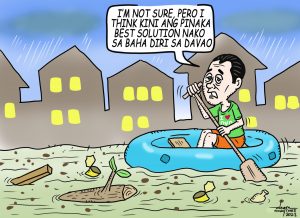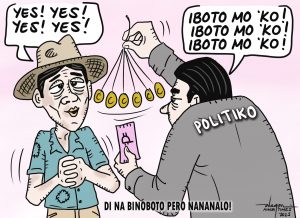LATE last week, we received an email from the Save Paradise Reef Movement, a convergence of people espousing concern on the future of the reefs on the sea on the side of the Island Garden City of Samal (IGaCoS) facing Davao City.
The organization thanked us for making the Paradise reef issue a subject in one of our columns last week. We’d like to let the group know that we, too, share the similar concern about that side of the strait and its massive formations of corrals. These are in addition to the so-called vanishing island not far from the Rodriguez-owned Paradise Island Resort.
That piece of sand bar, we are told, gets its tag “vanishing island” because during low tide, it protrudes above the water line together with the mangroves and “pagatpats” (a seashore growing tree variety). People can walk on the sandbar without getting their feet wet or they can wade on shallow water to look for shellfish or simply commune with nature’s gifts that exist in that minute piece of God’s creation.
And during high tide, the sandbar is swallowed by the sea and what can be seen are the upper half of the mangroves and “pagatpats” thriving in that particular stretch. Still, to visitors and passersby, it is a sight to behold.
As far as we know, that is the only sandbar existing in the island, and luckily for Davaoenos it is the only one visible both from Davao City and Samal sides. So we agree with the Movement that preserving that sandbar and the corrals that abound in its vicinity would have a lasting impact on the people than allowing its destruction to give way to an infrastructure project couched in the terminology of development.
But like the Movement itself, we are also not against the construction of the multi-billion span. We are for it a hundred and fifty percent. What we are in accord with the Movement is its desire to have the route of the bridge moved somewhere that it will not destroy that piece of nature and the nearby communities where the Samal approach is proposed to take off.
In other words, we see the Movement’s wisdom in advocating for the change of the bridge’s location as a means to protect the environment in that part of the island city, as well as ensuring that there will be no dislocation of economic or livelihood activities of people in the beach line areas that stand to be affected by the construction.
And if there is nothing from the protests made by the Movement and the affected communities, including beach resorts, to have the routes changed, then perhaps the Department of Public Works and Highways (DPWH), the implementing agency of the Samal bridge project, can still sit down for one or two more times to craft a “win-win” solution to the problem.
That is, that the government wins, the environment wins, and the community wins, as well. There is nothing as “It’s too late already.” For as long as those concerned agree to talk and tackle issues, there will always be some compromises that may come out in open and candid discussions.
We can only hope that the route issue of the bridge project will not reach the courts. If it will, then there is only one thing left certain. That is, that the project implementation will further be delayed and its expected economic impact to the island will remain unrealized.
Therefore, a “win-win” solution to be forged is imperative.
And talking of beaches, last Saturday, the national government through the Department of Environment and Natural Resources (DENR) and the local government of Manila showed the Filipino people and the rest of the world, a preview of what one component of the Manila Bay Rehabilitation project can do to restore lost grandeur.
Yes, last Saturday, the DENR and the Manila LGU opened to the public some 500 meters stretch of Manila Bay that was covered with grounded dolomite stones that resembled white sands.
The opening, which was presided by DENR Secretary Roy Cimatu and Manila Mayor Isko Moreno, gave those who came to witness the occasion one of the biggest surprises of their lives. Many of those interviewed likened themselves to have taken a vacation in Boracay, or in Miami in Florida, USA.
They said they could not believe seeing that an extremely impossible project could be done to improve the scene along the bay. The view from the sea was made even more exhilarating with the large and tall buildings on the other side of Roxas Boulevard as background. The white grounded dolomite was gleaming like it is a natural in that particular stretch of Manila Bay.
We were only viewing the occasion on television, and we cannot help but look at the postcard sent to us by a relative who now works in Romania. The postcard is an aerial shot of that country’s Black Sea coast. Running parallel to the white sand coastline is a wide road very similar to Roxas Boulevard in the Manila Bay area. On the other side of the road are Romania’s fashionable resort hotels, shopping malls, restaurants, and other tourism-related establishments.
The Black Sea coast of Romania, with its white sand beaches, has become the favorite “go-to” area of holiday makers.
Meanwhile, with Manila Bay given a new look on its beaches by the white dolomite covering, witnessing the once famous sunset in that area may even become a more meaningful experience. Besides the sunset, right below one’s eyes is another scenic view to behold; something that can take one to a travelogue to Boracay, to Miami, to Dubai, or to the Black Sea coast of Romania.
But, of course, the full realization of the Manila Bay rehabilitation project still has a long way to go, especially with the almost incessant protests from certain sectors claiming to be more knowledgeable and experts on environment and health issues.



